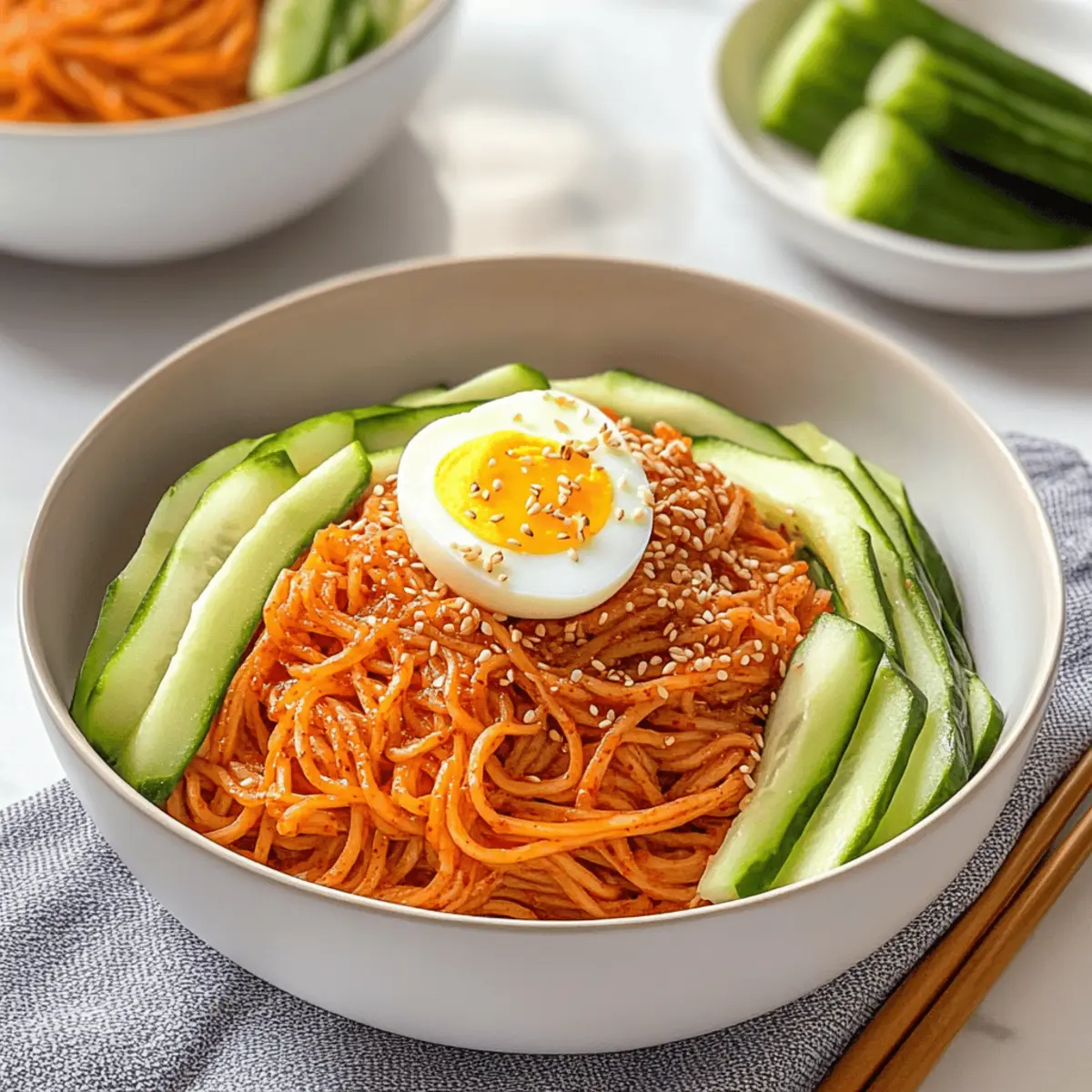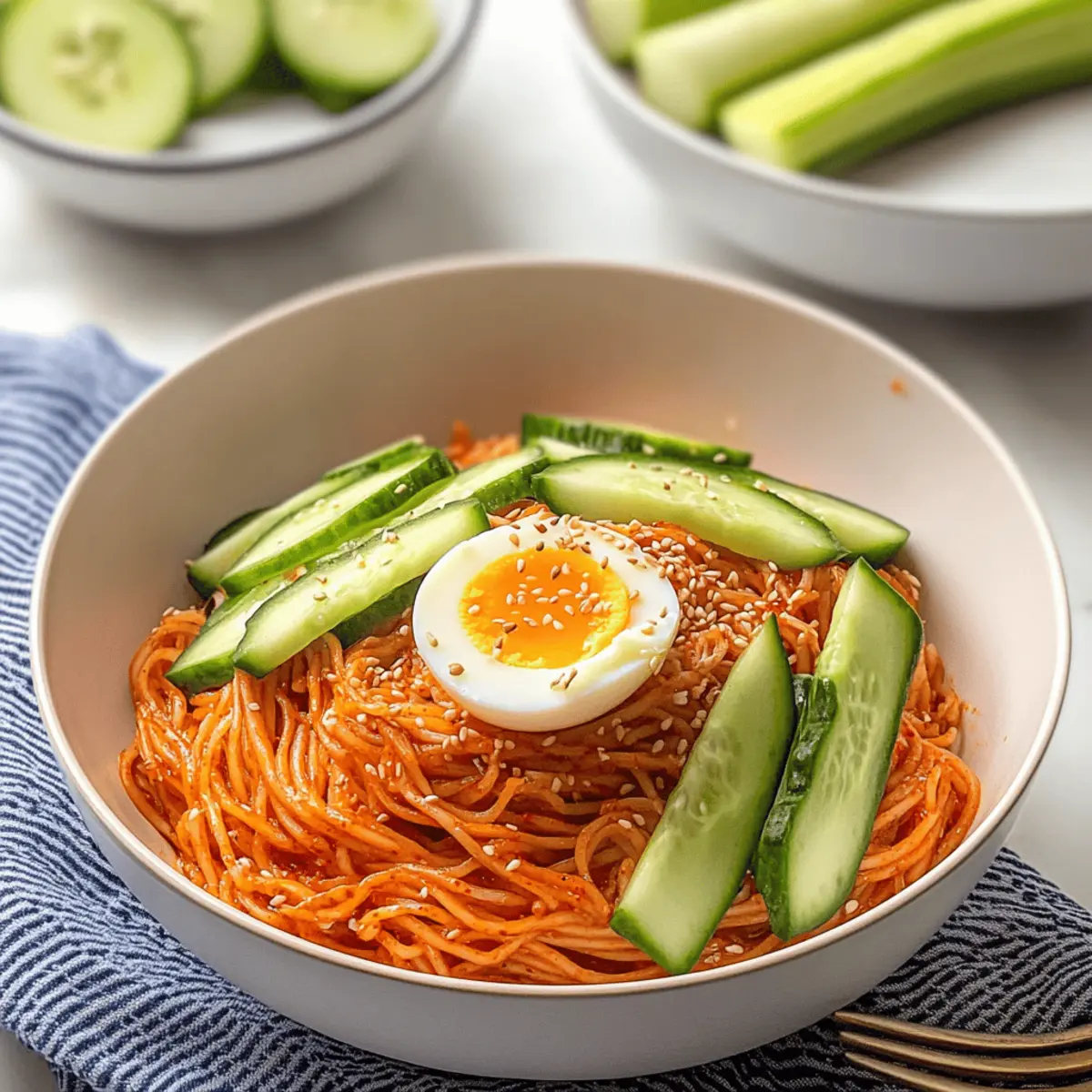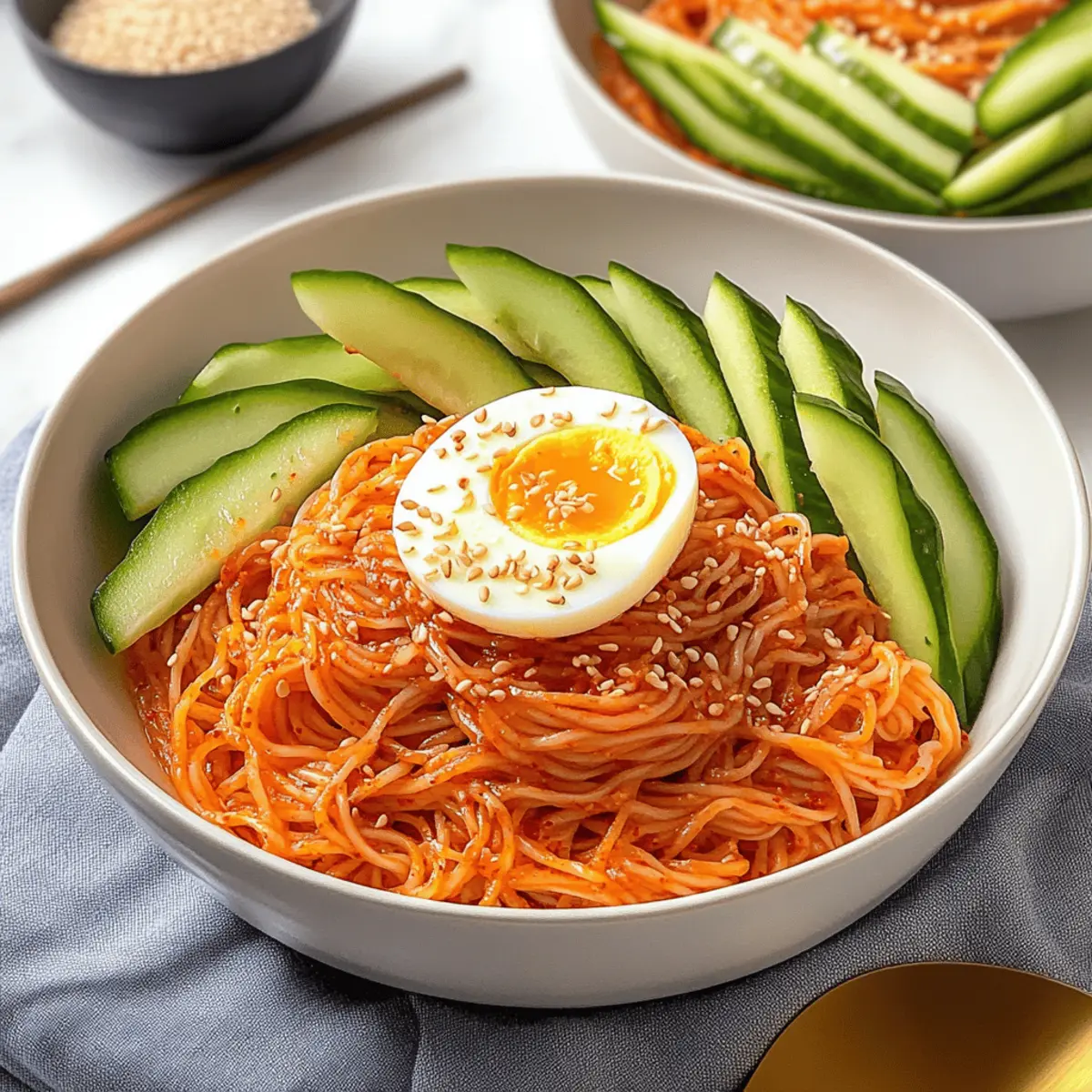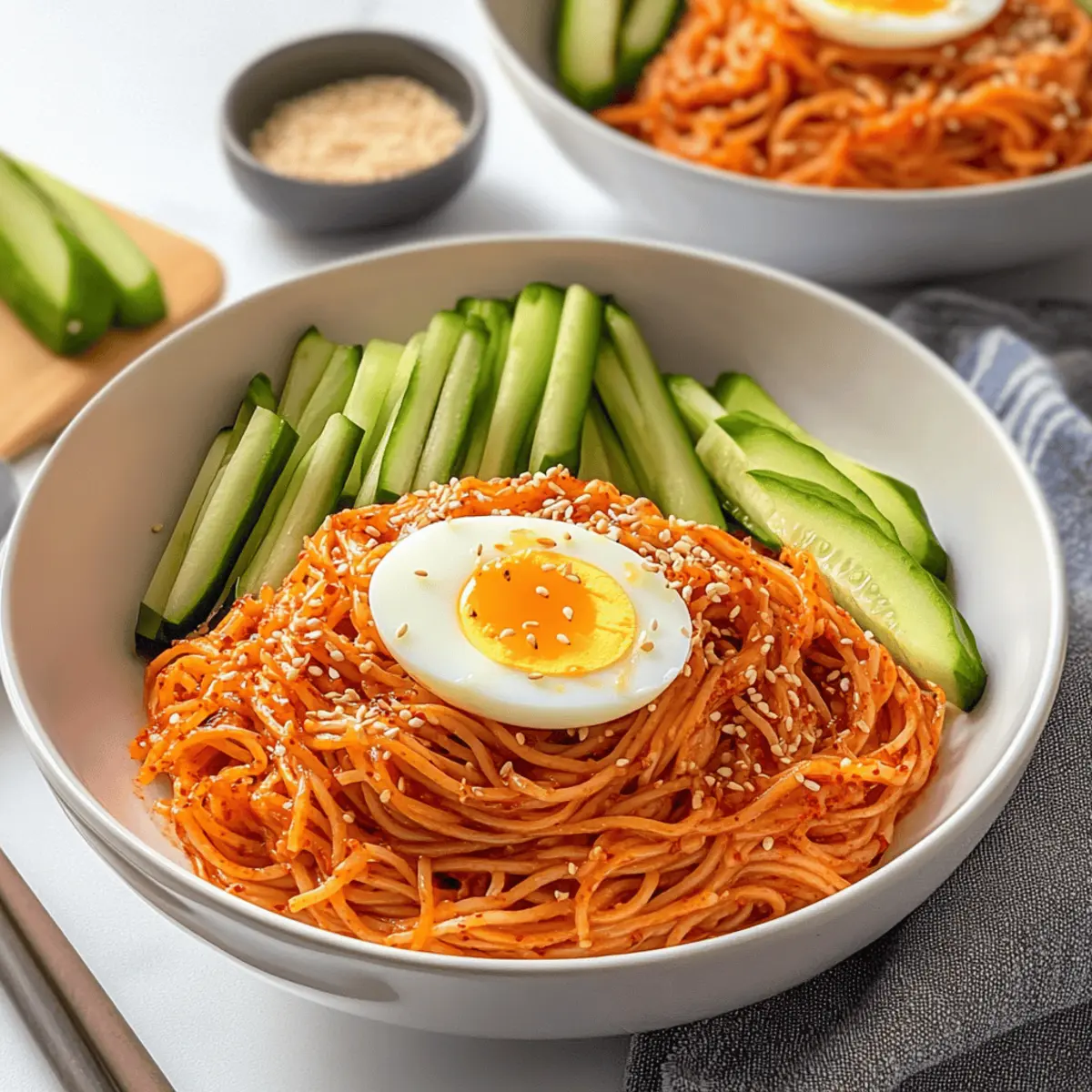As the sun blazes overhead, I find myself craving something cool, refreshing, and packed with flavor. That’s when I turn to my favorite quick fix: Bibim Guksu. These Korean spicy cold noodles come together in just 10 minutes, making them perfect for those hot summer days when the last thing you want to do is heat up the kitchen. Tossed in a sweet and spicy gochujang sauce, every bite of this dish not only tantalizes your taste buds but also brings an exciting twist to your meal plan. Plus, it’s entirely vegan-friendly, allowing everyone to enjoy its deliciousness guilt-free! Are you ready to elevate your dining experience with a bowl of irresistible Bibim Guksu? Let’s dive into the recipe!

Why is Bibim Guksu a must-try?
Quick Preparation: With just 10 minutes needed, this recipe is perfect for busy days when you want a fresh meal without the fuss.
Vibrant Flavors: The spicy gochujang sauce pairs beautifully with cold noodles, creating an explosion of taste in every bite.
Versatile Options: Feel free to customize with your favorite veggies or proteins for a meal that fits your cravings—consider adding grilled chicken or tofu for extra heartiness!
Healthy Choice: Nutritionally dense, Bibim Guksu is not only satisfying but also a great source of energy, making it perfect for a light lunch or dinner.
Crowd Pleaser: Whether for a family meal or a gathering with friends, this dish is sure to impress, and for even more inspiration, check out my guide on how to make perfect Korean sides to pair with your noodles!
Bibim Guksu Ingredients
• Get ready to whip up this refreshing dish with these essential ingredients!
For the Noodles
- Somyeon Noodles – Thin wheat noodles that provide the perfect base; substitute with rice noodles for a gluten-free option.
For the Sauce
- Gochujang – This Korean red chili paste adds the signature spicy depth; no direct substitute, but sriracha can offer a different twist.
- Gochugaru – Korean red pepper flakes enhance both heat and color; feel free to replace with paprika if you prefer a milder flavor.
- Soy Sauce – Boosts umami richness; tamari is a great substitution for a gluten-free recipe.
- Sesame Oil – Infuses nutty notes and depth; olive oil is an acceptable alternative if needed.
- Rice Vinegar – Balances the sauce’s sweetness with its acidity; apple cider vinegar works well as a substitute.
- Garlic – Minced for aromatic flavor; adjust the amount based on personal preference.
- Honey – Sweetens and balances the heat; use agave syrup to keep it vegan-friendly.
- Toasted Sesame Seeds – Perfect for garnish and added crunch.
For the Toppings
- Cucumber – Fresh and thinly sliced for that much-needed crunch; radish or zucchini can be substituted for a unique touch.
- Soft-boiled Egg – Optional but adds protein; simply omit for a vegan-friendly dish.
- Kimchi – Adds an extra kick and fermentation benefits as a delicious optional garnish.
Step‑by‑Step Instructions for Bibim Guksu
Step 1: Make the Sauce
In a medium bowl, combine 2 tablespoons of gochujang, 1 tablespoon of gochugaru, 2 tablespoons of soy sauce, 1 tablespoon of sesame oil, 1 tablespoon of rice vinegar, minced garlic, and honey to taste. Whisk the mixture vigorously for about 2 minutes until it’s well blended and smooth. Set the bowl aside, allowing the vibrant flavors to develop while you move on to the noodles.
Step 2: Cook the Noodles
Bring a large pot of water to a rolling boil over high heat. Once boiling, add 200 grams of somyeon noodles and cook according to the package instructions—usually about 4-5 minutes. As they cook, stir gently to prevent sticking. When they’re tender yet slightly chewy, drain the noodles and rinse them under cold water for 1-2 minutes to stop the cooking process and cool them down.
Step 3: Combine the Noodles and Sauce
In a large mixing bowl, add the cold somyeon noodles to the prepared sauce. Using tongs or your hands, gently toss the noodles with the sauce for about 1-2 minutes, ensuring every strand is evenly coated with the fiery red mixture. The vibrant color of the sauce will envelop the noodles, making them look irresistible.
Step 4: Prepare the Toppings
While the noodles sit coated in the sauce, thinly slice half a cucumber and prepare a soft-boiled egg if desired. To soft-boil, gently place the egg in boiling water and cook for exactly 6-7 minutes, then transfer to ice water to halt cooking. After a few minutes, peel the egg. Set the cucumber and egg aside, ready for the final assembly.
Step 5: Serve and Garnish
Divide the delicious Bibim Guksu among serving bowls. Top each bowl with the sliced cucumber, gently halved soft-boiled egg, and a sprinkle of toasted sesame seeds for added crunch. If you like, add a side of kimchi to enhance the flavors. Serve the dish cold and enjoy every flavorful bite!

Expert Tips for Bibim Guksu
-
Wash Your Veggies: Make sure to thoroughly wash all vegetables before slicing to ensure freshness and remove any impurities.
-
Control the Heat: Adjust the spice levels by varying the amounts of gochujang and gochugaru to your taste preferences. Start with less if you’re sensitive to heat!
-
Maximum Flavor: Allow the sauce to sit for a few minutes after mixing. This helps the flavors meld together and enhances the overall taste of your Bibim Guksu.
-
Noodle Texture: Make sure to rinse the somyeon noodles well under cold water. This stops the cooking and keeps them silky, which is key for the perfect cold noodle dish.
-
Experiment Freely: Don’t hesitate to add your favorite veggies or proteins—like julienned carrots, zucchini, or grilled chicken—to create a personalized version of this Korean dish.
-
Serve Chilled: To enjoy Bibim Guksu at its best, serve it cold. If you do reheat, be aware that the flavors may diminish, affecting your delightful experience!
What to Serve with Bibim Guksu
Elevate your Bibim Guksu experience by pairing it with delightful sides and beverages, each bringing a unique touch to your meal.
-
Korean Cucumber Salad: A refreshing and crunchy side that balances the spiciness of the noodles with a tangy sweetness.
-
Kimchi: This fermented classic adds an extra depth of flavor and heat, perfectly complementing the cold noodles.
-
Grilled Tofu Skewers: Lightly marinated tofu grilled to perfection provides a protein punch that pairs well with the vibrant sauce.
-
Sesame Spinach Salad: A smooth and nutty salad that offers great texture contrast, while sesame flavors echo those in the noodles.
-
Sweet Potato Fries: Crispy and sweet, they add an appealing contrast to the spicy bowl of Bibim Guksu for a comforting side.
-
Iced Green Tea: Cool and refreshing, this drink will cleanse your palate after each spicy bite, enhancing your overall dining experience.
-
Mango Sorbet: For dessert, indulge in a light and refreshing mango sorbet that wonderfully contrasts the heat and brings a sweet ending to your meal.
How to Store and Freeze Bibim Guksu
Refrigerator: Store leftover Bibim Guksu in an airtight container for up to 3 days. Enjoy it cold for an invigorating meal, as reheating may dilute the flavors.
Freezer: While it’s best to eat Bibim Guksu fresh, you can freeze the sauce separately in a sealed bag for up to 1 month. Just remember to prepare fresh noodles later for the best taste!
Preparation Tips: For the best texture, keep the noodles and sauce separate until you’re ready to serve, preserving the silkiness and flavor of the cold noodles.
Serving Suggestions: When ready to eat, just thaw the sauce and mix with freshly cooked noodles and toppings for a delightful meal!
Make Ahead Options
Bibim Guksu is a fantastic recipe for meal prep enthusiasts looking to save time during busy weeknights! You can prepare the sauce up to 3 days in advance by mixing all the ingredients, storing it in an airtight container in the refrigerator to keep the flavors vibrant. Additionally, you can cook the somyeon noodles and refrigerate them for up to 24 hours before serving; just rinse them under cold water again before tossing with the sauce. When you’re ready to enjoy, simply combine the prepped noodles and sauce, top with your fresh cucumber, soft-boiled egg, and sesame seeds, serving it cold for the same delicious experience as if it were freshly made!
Bibim Guksu Variations & Substitutions
Feel free to get creative with your Bibim Guksu and customize it to suit your taste buds. Let your culinary imagination run wild!
- Vegan Swap: Replace the soft-boiled egg with sliced avocado for a creamy texture that complements the dish perfectly.
- Gluten-Free Noodles: Use rice noodles instead of somyeon for a deliciously gluten-free twist that still captures that authentic cold noodle experience.
- Spicy Kick: For those who dare, add a few extra teaspoons of gochugaru or toss in some chopped fresh chilies to really turn up the heat!
- Veggie Boost: Throw in some julienned bell peppers or shredded carrots for an extra splash of color and crunch that boosts the nutritional value.
- Nuts & Seeds: Consider topping your dish with crushed peanuts or pine nuts for an added layer of richness and a delightful crunch—a perfect way to elevate your Bibim Guksu.
- Flavorful Fun: To experiment, replace honey with maple syrup for a different sweet dimension, making it a truly unique dish each time.
- Protein Power: Mix in grilled chicken or marinated tofu to turn this already delicious meal into a heartier one that satisfies your hunger.
- Soy-Free Option: Swap soy sauce with coconut aminos to achieve a similar umami flavor while keeping it soy-free.
Don’t forget, if you’re looking for delightful side dishes, pairing your Bibim Guksu with simple Korean cucumbers salad or savory Korean braised tofu will take your meal to the next level!

Bibim Guksu Recipe FAQs
How do I choose the right somyeon noodles?
Absolutely! When selecting somyeon noodles, look for thin, delicate wheat noodles that are typically found in Asian grocery stores. Check the package for a slightly translucent appearance, indicating freshness. If gluten-free is your goal, rice noodles are a great substitute!
How should I store leftover Bibim Guksu?
Very good question! Store any leftover Bibim Guksu in an airtight container in the refrigerator for up to 3 days. It’s best enjoyed cold, as reheating may diminish the flavors and texture. Just remember to toss it again before serving, to ensure every strand is coated in that delicious sauce.
Can I freeze Bibim Guksu?
Yes, you can! Although it’s best enjoyed fresh, if you want to freeze it, store the sauce separately in a sealed container or bag for up to 1 month. Then, you can prepare fresh noodles when you’re ready to indulge. Always mix fresh noodles with the thawed sauce and toppings just before serving for the best experience!
What if I find the sauce too spicy?
No worries! If you find the gochujang or gochugaru too spicy for your taste, start by using half the recommended amounts. You can always add more. Additionally, balancing the heat with a splash of more rice vinegar or a little more honey can help mellow out the spice while enhancing the flavor profile!
Are there any dietary considerations for Bibim Guksu?
Absolutely! Bibim Guksu is vegan-friendly as it’s made without any animal products. Just be cautious with the optional soft-boiled egg and use agave syrup instead of honey for a fully vegan dish. If you have allergies, ensure that the soy sauce is gluten-free (use tamari) and double-check the ingredients in your gochujang.
How do I prevent the noodles from sticking together?
Great question! To prevent the somyeon noodles from sticking, stir them gently while cooking to ensure they separate. After draining, rinse the noodles under cold water for about 1-2 minutes to cool them down and remove excess starch. This will help keep them beautifully silky when you mix them with the sauce!

Bibim Guksu: Quick & Spicy Korean Noodles That Refresh
Ingredients
Equipment
Method
- In a medium bowl, combine 2 tablespoons of gochujang, 1 tablespoon of gochugaru, 2 tablespoons of soy sauce, 1 tablespoon of sesame oil, 1 tablespoon of rice vinegar, minced garlic, and honey to taste. Whisk the mixture vigorously for about 2 minutes until it's well blended and smooth. Set the bowl aside.
- Bring a large pot of water to a rolling boil. Add 200 grams of somyeon noodles and cook according to package instructions for about 4-5 minutes. Drain the noodles and rinse under cold water to cool them down.
- Add the cold somyeon noodles to the sauce. Toss the noodles with the sauce for about 1-2 minutes, ensuring every strand is evenly coated.
- Thinly slice half a cucumber and prepare a soft-boiled egg if desired. Cook the egg for 6-7 minutes in boiling water and transfer to ice water to halt cooking.
- Divide the Bibim Guksu among serving bowls. Top with sliced cucumber, halved soft-boiled egg, and toasted sesame seeds. Add kimchi if desired. Serve cold.

Leave a Reply